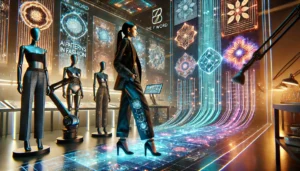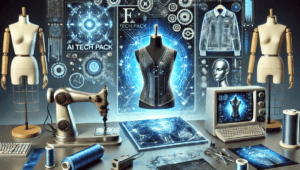Technology in Fashion: The Future of Style and Innovation
Welcome to the cutting-edge convergence of fashion and technology. Stay with us to explore the latest tech trends redefining the industry’s landscape.
If you thought fashion and technology were worlds apart, think again. Digital innovations are reshaping the way we dress and express ourselves, as well as how clothes are designed and bought. The world of fashion is undergoing a tech makeover.
Digital Fashion: Fashion Design in The Digital Sphere
Fashion and technology are converging in digital fashion, which involves creating virtual clothing in 3D that can be worn by both digital and real people if brought to the physical plane. It is an alternative to traditional pen-and-paper design, with artists experimenting with AI fashion design software to bring their concepts to life based on pre-orders.
It is also a new form of self-expression, with outfits and accessories designed to exist online, dressing up avatars in games, providing content for social media, and serving many other purposes in the metaverse. The possibilities are endless in the realm of digital garments and collections, where creativity knows no bounds.
Additionally, 3D fashion design software has leveled the playing field, allowing designers to bring their visions to life with unparalleled precision and detail from all angles. Prototypes can be created and modified faster, saving time and resources.
This innovation benefits both established brands and emerging designers, as accessibility is a key part of 3D design. More people can explore their creativity without a fashion degree or expensive equipment.
AI: Revolutionizing Fashion Design
What if, instead of spending valuable time and energy putting together the perfect outfit, you had a virtual stylist in your pocket? This is exactly what AI fashion assistants can do. These intelligent systems recommend clothing items and styles based on individual preferences and body type.
By analyzing vast amounts of data from runway shows, social media, and sales metrics, AI tools predict consumer preferences and inform design decisions. AI-driven fashion technology can:
- Recommend outfits based on past purchases and personal style.
- Enhance trend forecasting by analyzing colors, patterns, and silhouettes.
- Enable dynamic marketing content creation through text-to-video conversion.
- Improve customization with AI-generated, made-to-order garments.
AI technology streamlines the shopping experience while reducing returns and increasing customer satisfaction.
Augmented Reality (AR): Bridging the Physical and Digital
Gone are the days of ordering an outfit online, only to be disappointed when it doesn’t fit as expected. AR clothing try-ons allow shoppers to overlay garments onto their digital image using a smartphone or smart mirror, making online shopping more accurate and enjoyable.
With AR, shoppers can:
- Visualize how different sizes, styles, and colors look before making a purchase.
- Layer outfits and accessories to curate a complete look.
- Avoid the hassle of dressing rooms by trying on clothes virtually at home.
For retailers, AR technology reduces return rates and enhances customer satisfaction by offering a more personalized shopping experience.
NFTs: Owning Fashion in The Digital Age
NFTs (Non-Fungible Tokens) turn digital clothing into unique virtual assets, as verifiable and ownable as a physical handbag. You can purchase and own exclusive digital designs, showcase them on social media, or use them for avatars across the metaverse.
The fashion NFT marketplace provides new revenue streams for both creators and consumers while allowing individuals to own one-of-a-kind fashion pieces. As the demand for digital self-expression grows, NFT-based fashion continues to gain traction.
Sustainable Fashion: Reducing Waste with Technology
Technology in fashion is not just about aesthetics—it’s also driving sustainability. The traditional fast fashion model leads to excessive waste, high energy consumption, and overproduction. Digital fashion offers a more eco-friendly alternative.
With 3D design tools and virtual try-ons, brands can:
- Reduce physical waste by creating on-demand designs.
- Minimize returns, preventing overstocked items from ending up in landfills.
- Eliminate the need for multiple physical samples, reducing resource consumption.
By leveraging digital solutions, fashion brands can embrace sustainability without compromising on creativity.
Blockchain: Transparency and Ethical Fashion
Consumers today want more than just stylish clothing—they want to support brands that align with their values. Blockchain technology enhances transparency and accountability in the fashion industry.
With blockchain, shoppers can:
- Trace a garment’s journey from fabric sourcing to production.
- Verify ethical labor practices and sustainability efforts.
- Make informed purchasing decisions based on a brand’s integrity.
This level of traceability empowers consumers and pushes brands toward more ethical practices.
The Future of Fashion: Where Technology Meets Style
As fashion and technology converge, the possibilities are limitless. Brands and designers that embrace innovation—whether through AI, AR, NFTs, or sustainable production—are not just keeping up with the industry’s evolution; they are leading it.
Joining the digital future of fashion is necessary to meet the expectations of today’s savvy consumers, who value sustainability, crave unique self-expression, and demand seamless shopping experiences.
FAQs
1. How is digital fashion different from traditional fashion?
Digital fashion focuses on creating 3D virtual garments for use online or in the physical world if materialized. It allows for limitless creativity, reduced waste, and efficient design processes, unlike traditional fashion, which relies heavily on physical resources and manual techniques.
2. What are the benefits of 3D fashion design software?
3D fashion design software enables:
- Faster prototyping and adjustments.
- Accessibility for artists without formal fashion training.
- Precise visualizations of garments from all angles.
- Cost and resource savings by minimizing physical sampling.
3. How does AI impact fashion design and shopping?
AI revolutionizes fashion by:
- Recommending clothing based on preferences and body type through virtual assistants.
- Analyzing trends from runways and social media to guide design decisions.
- Enabling hyper-personalization to improve customer satisfaction.
- Optimizing inventory and reducing returns with predictive analytics.
4. What is AR clothing try-on, and how does it enhance shopping?
AR clothing try-on uses technology to overlay virtual garments onto your image. Shoppers can visualize fit, style, and color combinations in real-time, reducing returns and improving purchase confidence without stepping into a fitting room.
5. What role do NFTs play in fashion?
NFTs in fashion represent unique digital assets that can:
- Allow ownership of exclusive digital clothing.
- Be showcased in the metaverse or on social media.
- Gain value over time, creating new revenue streams for creators and consumers.
6. How is technology driving sustainability in fashion?
Digital fashion and tech tools promote sustainability by:
- Producing designs based on demand, reducing overproduction.
- Offering virtual try-ons to minimize returns.
- Eliminating physical samples with digital prototyping.
- Reducing waste associated with fast fashion.




